Complexity
builds organization.
Fractal mathematics models some of it. But
something is missing, another dynamic is at work, one not so fragile. A companion
mechanism.. robust and non-fractal.
Integrity research began
circa 1965, comparing how systems process energy and utilize information. A pattern
immediately revealed itself in every system studied. When modeled in a layered
hierarchy of organization, one in relation to others, it became apparent that behaviors in
adjacent layers alternated in their directions of entropy. That is, when membership of a
given level dissipated entropically, the typical result would be induction of neg-entropy
order-formation in the next broader scale of organization. And vice versa. Specific
mechanisms were of no consequence. This singular relationship shone through with absolute
regularity.
The mathematically geometric and behaviorally
expressive architecture of Integrity Dynamics is philosophically formidable -- potently
challenging neo-Platonism, Gödel's Incompleteness theorems, and the supremacy of Fractal
Emergence. It presents an architecture
of exponentially nested infinities -- Cantorian infinities -- where the entire structure is informationally accessible
throughout. Not just a structure of superpowers, but relationship of information filled
domains, dynamically interactive, topologically connected.
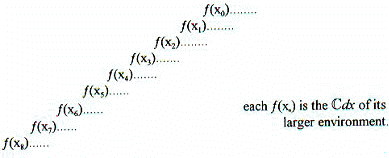
There are no closed formal
boundaries anywhere in existence or mathematics -- only conditional ones, limited by immediate utility. Our mathematical universe of nested and
coded dimensions is as much an architecture of many-environments, with varying information
bit-sizes, as the physical universe is. They are related, and the activities and behaviors
of any information integrates with and affects information on other levels. Fractal
Complexity is still involved, but now forms a sub-dynamic within the broader organization.
The Integrity Paradigm builds on foothold ideas of
'information', 'concept space', 'dimensional analysis', 'adaptive evolution', and
'emergence' ... embracing them under a single compatible vision. It claims that the principle mechanism of
Complexity is the dynamic of alternating 'local entropy' gradients, interlacing
exponentially nested levels, connecting the universe's assemblies of assemblies, which are
engaged in transformations and transactions of information.
R
EL
µ ------
ES
Entropy of the
larger assembly is inversely proportional to the entropy of the sub-assembly.
R
EL µ ----------------
ES = Pab · Pba
{ probabilities greater than 0 ;
probabilities 'vanish' by becoming '1'}
Exponents now represent autonomous yet
interrelated infinite domains, where the focus becomes determining what information
relationships exist between successive exponential domains. There is more involved
than just fractal mapping of one n-dimensional phase space onto another. Each can have an
independent entropy. Each can retain 'information content' or content potential, even when
coded to zero. Nested assemblies of phasespace are therefore fully environmental
to one another, each exponential level being its own continuum, a functional Cantorian
Infinity, with the potential of being utilized as an independent frame-of-reference, or
correspondent one.
Thematically then, we have two
kinds of emergence -- fractal and environmental or dimensional emergence. Their differences are obvious. Fractal emergence
functions in isolation. Nascent unknown patterns show up regardless of context.
Environmental emergence on the other hand, is completely relational. It is context
and interaction driven, as it produces new information and energy organizations.
Interactional changes in a given content or its relative option space will
produce new patterns, new assemblies of organization.

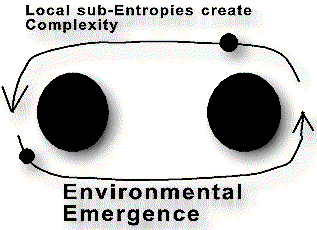
Both are mechanisms of Complexity. But
Environmental Emergence is far and away its more pervasive and robust form. In the simplest case, two non-zero probabilities
of communication present between two members of a given assembly level are sufficient to
enact Complexity.
{As in this video of jugglers}


It is the enactment of
communication potentials -- communication probabilities which correspond with entropy
changes of the data sub-assembly. They directly affect and narrow the information
exchanges possible among sources and receptors in the larger assembly. That limits the
freedom of interaction of that next larger order of assembly. This imposes a reduction in
the entropy of the next larger level. It forces neg-entropy. It forces
Complexity. Non-fractally.
We can now surpass Gödel's
Incompleteness Theorem. There will always be Gödel Limits - content less-than all - but
the characteristics superior to quantification are coherence and compatibility...
any information or energy on the far-side of a local Gödel Limit has the potential to
be included inside. What is external is compatible with what is internal. So, we know something very specific about parts of
the universe and of mathematical space which Gödel implies we should have no knowledge.
A gödel limit is not so much exclusionary-boundary as it is accessible-interface. The event-horizon of a Black Hole is a prime example.
Obviously it exists as a transition state separating regions of supposedly incompatible
information. But, it's truer importance is as a channel which information and energy can
be transduced through. Gödel is not the final word.
Environmental set concepts call into question
Plato & Gödel. If Gödel is accurate there can be no Platonic
ideals. The Ideal Set apple and the Set colors are mutually exclusive
if we are to be faithful to Gödel. An apple's color can only be known by interactions
which the set boundary - its skin - has with the external environment, and, since
the skin is a Gödel Limit, those sets are conceptually and existentially isolated.
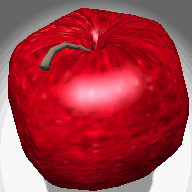
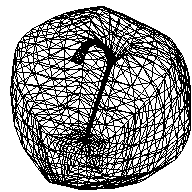
'Ideal Apple' with
environment
'Ideal Apple' without environment
(including trans G-limit information)
(excluding trans G-limit information)
For a platonic apple to have color, existence has
to be Martin Buber's dynamic, 'I-Thou'. When environments exist, sets
are completable. This holds true even for mathematical systems. As long as they
exist in potential context with other possible mathematics, they can be complete.
Validation within a closed system is also available. Self verification and consistency can be attained by evaluating any
and all possible sub-partitions - transitory internal gödel-limits. Verity
rests in having an infinite number of option sets which are open to review and testing.
Anomalies are natural and native, with the distinction of merely being local and
conditional.
Eigenspace Options: Surviving in real environments
Sustained behaviors require
the ability to deal with both the known and the unknown. Action in relation to
potential. Firstly, the initial memory of any system is
not carried data, but the rules of construction... the fundamental forces, relativity,
entropy. They determine activity and action space. Even in the ultra-heat of initial
creation, information was already present to enact the products of symmetry breaking and
cooling.
As cooling occurred, enduring in extended
environments required compatibility .. the ability to cope with encounters by avoidance or
interaction. Self-organized systems therefore need empty eigenstates...states of ignorance
if you will ... having the available capacities to encounter new information or energy.
Maximum information or energy content therefore is totally antithetical to the health, the
integrity, of any dynamic system. It cannot be its goal. Determinism over-formalizes
systems, lessens survivability because behavioral options are removed. There is nothing
efficient or functional about a computer which data storage and operating spaces are
saturated. Atoms survive not because they settle into unchanging persistent energy
configurations (save for quantum variability), but because quantum electron shells are
available, being adaptive to changes in energy content. It is an error - though an
understandable one - to think that Complexity rides at stability nodes poised between
chaos and order. The truth is that Sustained Organization persists in a range between too
much energy or information, and too little -- with priority placed on the constructive
capacity to handle energy and information possibilities. More than sufficient, less
than saturation.
| INTEGRITY |
|
 |
Change
in Eigenspace, Change in Entropy
In every complex system imaginable room-for-change
is identifiable as variability-of-entropy, plus or minus. We can now evaluate the impacts
such local entropy changes have in relation with their surroundings. We discover that the
behavior-space of a subset domain of a system alters inversely the behavior-space of
framing agents. The entropies are inversely dynamic and interdependent. And it doesn't
matter if the motivating energy or inductive change of phasestate comes from the
sub-system or the external environment. The relational dynamic holds regardless. This is
the crucial concept. Integrity vs Complexity.
A system's integrity - its sustained
dynamic self organization in extended environments - is not a state poised between
order and chaos, but a functioning option-space poised between rigid determinism and the
full statistical potential of much greater self-with-environment behavior space. Even
adaptive evolution uses extant mechanisms to find new integrity options - surviving by
changing.
Nested entropies enact their opposite-gradients
when their physical qualities are compatible, especially the behavior values of accessible
overlapping momentums and locations ... compatible variables of Heisenberg Intersections.
'Geometry and Activity of Information Topology'
The Integrity Paradigm yields other
important notions,
mentioned here briefly.
Statistics and Fields.
Integrity strongly asserts that time dimensions precede quantum mechanics. Statistical
distributions are behavior sets with the time dimension compressed. Temporal events in
n-dimensions are reduced to n-1 dimensions. Action gradients are removed, not absent by
default. If no gradient is present enabling behaviors, no statistics get generated.
Period. For example, a ball bearing peg-board that generates a bell-curve. Remove it from
a gravity well. Nothing happens. An action potential must be pre-present in any and all
cases where statistical accumulations occur.
 |
G |
 |
| not just Sigma~function, |
|
but Gradient Sigma~function. |
Also, energy and information
throughputs must be process-compatible with the structure and handling capacities of the
system it transits. Changes in internal structure, or changes in throughputs, can generate
significantly different distribution curves. Like a bowling ball sent through a
ball-bearing appropriate pegs & board device, instead of ball bearings; the
'gaussian curve' generated is a vertical line.
Information Topology. Pythagorus' contemporary
Apollonius, defined an alternative way to describe waves. The reference base of a circle
(and thus all wave functions) is no longer some central focal point. A circle or wave
function is also generated by twin orthogonal conditions stemming from an originating
point (of dimension zero), out along any linear extension of dimension-one. The point
persists as endpoint, not midpoint, of the one dimensional object. As in 'x = rho Sine
Theta'.
Many interesting things arise from
this.
By the Law of the Excluded Middle we generate a
limit condition which is tantamount to 'wave collapse'. It seems that particle-wave
duality is a dimensional compression event... enacted events of Cantorian Aleph
infinities, where the infinity of a line is equal to the infinity of a plane C=B squared.

If we map this relationship as wave functions out
from the vertex of an acute angle, we find two things. First, the number of one-half wave
units along each side generates the same partitioning along an orthogonal line
perpendicular to the mid-line of the angle ... regardless of the size of the angle! This
means that the information content of the orthogonal domain is consistently identical with
the information n of n(Lambda/2) , no matter how small the angle gets ... even reduced to
zero. Perfect orthogonal transference of information This is dimensional
coding/compression. This is the foundation of holography and sonoluminescence.

Another result comes when we look at the smallest
state of orthogonal information-bit transcription. The base state is (Lambda/2). It is
represented by an equilateral triangle inside a circle. This geometry represents several
co-present states of symmetry. If we rotate the wave function around its internal axis of
symmetry until it maps-itself, so to speak, these mappings come in units of +/- 1/3 and
2/3. We now have a situation which conjoins halves and thirds ... the underlying symmetry
of quark architecture, where the thirds are present and real, but are transcendently
relational. That is, they are functionally intrinsic factors, but have no independent
identity or physical reality outside the enactment of the architectured process.
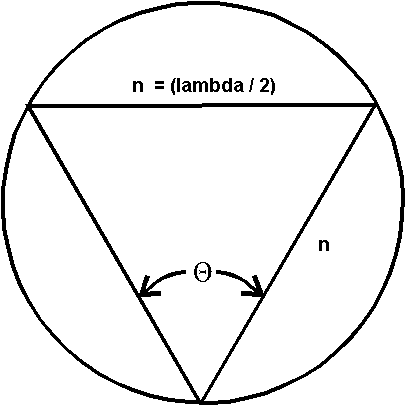
Information symmetry of UNITS.
Wave symmetry of HALVES.
Spatial rotation symmetry of THIRDS.
Topology Tree:
Information Structure of Dimensions
The next diagram shows information topology in
dimensions 0-4. A seminal point - which is able to competently carry almost any amount of
information we can impose - extends it into a plurality of orthogonal dimensions. The
graphics show a natural lineage of geometries with correspondence to laminar examples of
the fundamental forces ... and more, even helical ordering, and orderings as yet
unevaluated.

Maxwell's Demon & the Turing Machine
: Dynamic Isomorphism
Given the thesis that all functions and dynamics are environmentally related
and bound, we can turn our attention to two imageries dear to 20th century science:
Maxwell's Demon and the Turing Machine. The Integrity Paradigm now evaluates them as being
absolutely one and the same. They are epitomes of fundamental Complex systems, even
conscious systems, because they rest upon the integrated process where n-component factors
have an n-probability information exchange at all times.
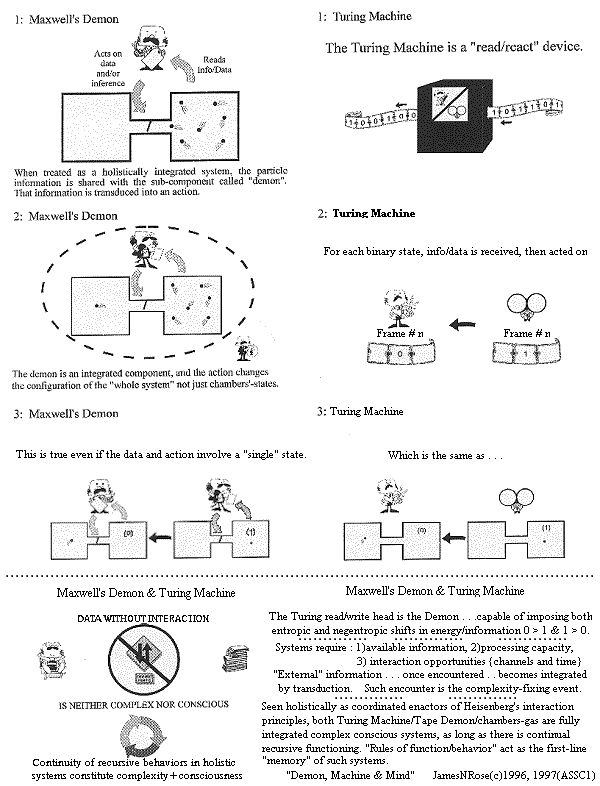
Summary
Stable continuation of Complex organization is
enacted across a range of opportunity available, environmentally relevant, behaviors
instead of some singular states of poise teetering between chaos and order.
Complexity is not an anomaly, mysteriously swimming upstream against some irrepressible
law of energy dissipation. It is the most natural and pervasive activity of
the universe, a product of the geometry and metrics of information topology.
Local entropy assemblies interacting and communicating with other local entropy
assemblies.
The Integrity Paradigm forcefully redefines the
philosophical meaning of Complexity. Complexity is the existential condition of
behaviors bound together in sustained recurrence. Any processes or forces or dynamics or
relationships which satisfy that simple definition, will qualify a system as
complex. And such systems are everywhere, they are what the universe is
all about. A nested topology of dimensionally integrated relational information,
environments impacting environments. Activities embedded in a Dyson universe that is
quite literally infinite in all directions.
The Integrity Paradigm is an umbrella concept,
embracing all systems behaviors, translating all the diversity, distilling out shared
qualities. It respects the integrity of individuation, but always places such
identity in context with the universe abundantly around. *Experience* is
personal, even as all things share the ability *to* experience. Integrity reminds us that potential and opportunity are the most valuable commodities of existence.
Entities may not endure, relationships do - always and forever.
| N o n - F r a c t a l C o m p l e x
i t y
Dynamic
organizations thriving
in ranges of
|
2025 Copyrights ceptualinstitute.com













